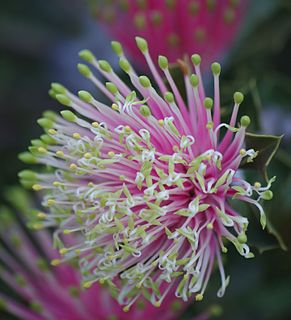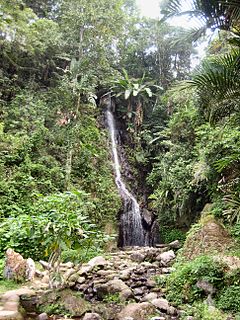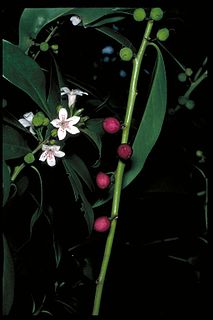
Southwest National Park is an Australian national park located in the south-west of Tasmania, bounded by the Franklin-Gordon Wild Rivers National Park to the north and the Hartz Mountains National Park to the east. It is a part of a chain of national parks and state reserves that make up the Tasmanian Wilderness World Heritage Area. Covering an area of 6,183 km2 (2,387 sq mi), it is Tasmania's largest national park.

Banksia cuneata, commonly known as matchstick banksia or Quairading banksia, is an endangered species of flowering plant in the family Proteaceae. Endemic to southwest Western Australia, it belongs to Banksia subg. Isostylis, a sub-genus of three closely related Banksia species with inflorescences or flower clusters that are dome-shaped heads rather than characteristic Banksia flower spikes. A shrub or small tree up to 5 m (16 ft) high, it has prickly foliage and pink and cream flowers. The common name Matchstick Banksia arises from the blooms in late bud, the individual buds of which resemble matchsticks. The species is pollinated by honeyeaters (Meliphagidae).
Banksia oligantha, commonly known as Wagin banksia, is an endangered species in the plant family Proteaceae endemic to south west Western Australia. It belongs to Banksia subg. Isostylis, a subgenus of three closely related Banksia species with dome-shaped heads as inflorescences, rather than characteristic Banksia flower spikes. A shrub or small tree up to 4 m (13 ft) high, it has prickly foliage and pink and cream flowerheads which appear in late Spring.
The ecology of Banksia refers to all the relationships and interactions among the plant genus Banksia and its environment. Banksia has a number of adaptations that have so far enabled the genus to survive despite dry, nutrient-poor soil, low rates of seed set, high rates of seed predation and low rates of seedling survival. These adaptations include proteoid roots and lignotubers; specialised floral structures that attract nectariferous animals and ensure effective pollen transfer; and the release of seed in response to bushfire.

The flora consists of many unique varieties of tropical plants. Blessed with a tropical climate and around 17,000 islands, Indonesia is a nation with the second largest biodiversity in the world. The flora of Indonesia reflects an intermingling of Asian, Australian and the native species. This is due to the geography of Indonesia, located between two continents. The archipelago consists of a variety of regions from the tropical rain forests of the northern lowlands and the seasonal forests of the southern lowlands through the hill and mountain vegetation, to subalpine shrub vegetation. Having the second longest shoreline in the world, Indonesia also has many regions of swamps and coastal vegetation. Combined, these all give rise to a huge vegetational biodiversity. There are about 28,000 species of flowering plants in Indonesia, consisting 2500 different kinds of orchids, 6000 traditional medicinal plants used as Jamu., 122 species of bamboo, over 350 species of rattan and 400 species of Dipterocarpus, including ebony, sandalwood and teakwood. Indonesia is also home to some unusual species such as carnivorous plants. One exceptional species is known as Rafflesia arnoldi, named after Sir Thomas Stamford Raffles and Dr. Thomas Arnold, who discovered the flower in the depths of Bengkulu, southwest Sumatra. This parasitic plant has a large flower, does not produce leaves and grow on a certain liana on the rain forest floor. Another unusual plant is Amorphophallus titanum from Sumatra. Numerous species of insect trapping pitcher plants can also be found in Borneo, Sumatra, and other islands of the Indonesian archipelago.

Phillip Island is an island located 6 km (3.7 mi) south of Norfolk Island in the Southwest Pacific, and is part of the Norfolk Island group. It was named in 1788 by Lieutenant Philip Gidley King after Arthur Phillip, the first Governor of New South Wales. Phillip Island is part of the Australian external territory of Norfolk Island, and is included in Norfolk Island National Park, as is neighbouring Nepean Island and about 10 percent of Norfolk Island proper.

Norfolk Island National Park is a protected area of 6.50 km2 (2.51 sq mi) located at 29°2′0″S167°56′59″E in the South Pacific Ocean, about 1,471 kilometres off the East coast of Australia. The park’s area includes the Mount Pitt section on the namesake Norfolk Island with an area of 4.60 km2 (1.78 sq mi) / 460 ha, as well as the neighboring Phillip Island encompassing 1.90 km2 (0.73 sq mi) / 190 ha, and the much smaller Nepean Island. The Norfolk Island group is a Commonwealth of Australia external territory, and is the only place in the world where the Norfolk Island parakeet and the white-chested white-eye occur.

The Western barred bandicoot, also known as the Marl, is a small species of bandicoot; now extinct across most of its former range, the western barred bandicoot only survives on offshore islands and in fenced sanctuaries on the mainland.

Hibiscus insularis, the Phillip Island hibiscus, is a species of flowering plant in the mallow family Malvaceae, that is endemic to Phillip Island, a small island to the south of Norfolk Island, Australia. The entire natural extent of this species is just two small clumps, and each clump apparently consists of multiple separate stems of a single genotype. It has been propagated and planted more widely on Phillip Island, but only vegetatively which does not increase the genetic diversity. Seedlings apparently have not been observed in the wild. It produces greenish-yellow flowers that fade to mauve through most of the year.

Astragalus nitidiflorus is a species of legume in the family Fabaceae. It is endemic to Cartagena, southeast of Spain. It was refound after about 100 years of extinction and "the reappearance of this species has awakened the interest of environmental managers because the reasons for its critical situation are unknown". In 2004, a group of 46 specimens were discovered in a protected area between Cartagena and Mazarrón and plans for the conservation of this species have been implemented. ISSR markers helped to find that Astragalus nitidiflorus has a low genetic diversity. "This species grows in shallow soil from metamorphic and volcanic rocks in between mountain and cultivated areas".

The flora of Australia comprises a vast assemblage of plant species estimated to over 20,000 vascular and 14,000 non-vascular plants, 250,000 species of fungi and over 3,000 lichens. The flora has strong affinities with the flora of Gondwana, and below the family level has a highly endemic angiosperm flora whose diversity was shaped by the effects of continental drift and climate change since the Cretaceous. Prominent features of the Australian flora are adaptations to aridity and fire which include scleromorphy and serotiny. These adaptations are common in species from the large and well-known families Proteaceae (Banksia), Myrtaceae, and Fabaceae.

Coprosma baueri is an endangered shrub species in the plant family Rubiaceae. It is endemic to Norfolk Island, including nearby Phillip Island. Convict artist John Doody drew this species in 1792, its first record. He noted it grew only where exposed to the sea and was seldom taller than 3.7 m. He also recorded that its fruit are good to eat. Ferdinand Bauer collected the type specimen in 1804–05. In 2003 only about 228 mature plants were known. By 2009 Mills reported the number of plants on Phillip Island had increased to 446, about 170 of which were taller than one metre. Until rabbits were eradicated from Phillip Island it had been very rare there.
Achyranthes margaretarum is a species of plant belonging to the family Amaranthaceae. It is endemic to Phillip Island, close to Norfolk Island in the south west Pacific Ocean, where it was discovered during the 1980s after rabbits had been eradicated from the island. This provides dramatic evidence of the value of the eradication program. It is considered critically endangered due to its very small population size - fewer than 20 mature individuals were known, in a single location on Phillip Island, in 2003. In 2009 Mills identified 22 plants on Phillip Island, including planted specimens, only nine higher than 50 cm.

Grevillea iaspicula, commonly known as Wee Jasper grevillea, is a species of endangered shrub that is endemic to southern New South Wales.

Grevillea acropogon is a species of flowering plant in the family Proteaceae and is endemic to a restricted part of southwestern Western Australia. It is a prostrate to erect shrub with pinnatisect leaves with five to seven sharply-pointed lobes, and red flowers.
Corybas dienemus, commonly known as the windswept helmet-orchid, is one of two helmet orchids endemic to Australia's subantarctic Macquarie Island, and the first orchid to be found there. It is a relatively small orchid with green flowers with purplish-red markings and was discovered in 1978.
Grevillea scapigera, commonly known as Corrigin grevillea, is a small shrub which is endemic to a small area of the Wheatbelt region in Western Australia. In 1987 it was listed as was declared as Rare Flora under the Western Australian Wildlife Conservation Act 1950 then listed as Critically endangered in 1995. According to the Environment Protection and Biodiversity Conservation Act 1999 it is listed as endangered as a result of it's lack of critical habitat, habitat fragmentation, seed predation, weeds, rabbits and salinity.

Myoporum obscurum, commonly known as popwood, sandalwood or bastard ironwood is a plant in the figwort family, Scrophulariaceae. It is a very rare shrub, endemic to Norfolk Island where it occurs in a few scattered locations.
Grevillea brachystylis grandis, commonly known as large-flowered short-styled grevillea, is a subspecies of Grevillea brachystylis.

Achyranthes arborescens is a plant in the Amaranthaceae family endemic to Norfolk Island. It is a critically endangered species under the Australian Federal government's Environment Protection and Biodiversity Conservation Act.















